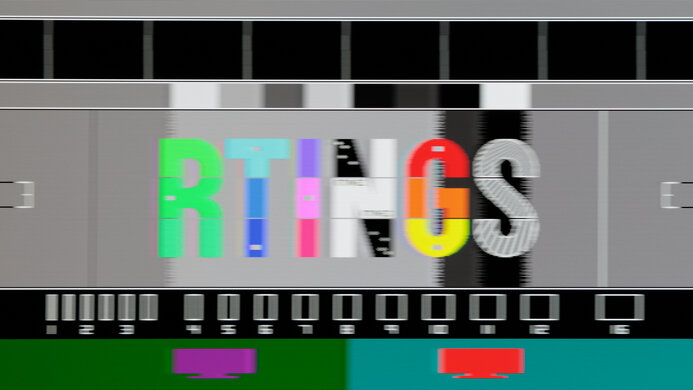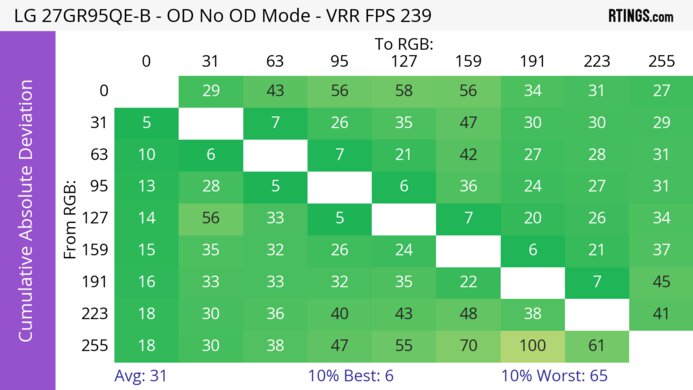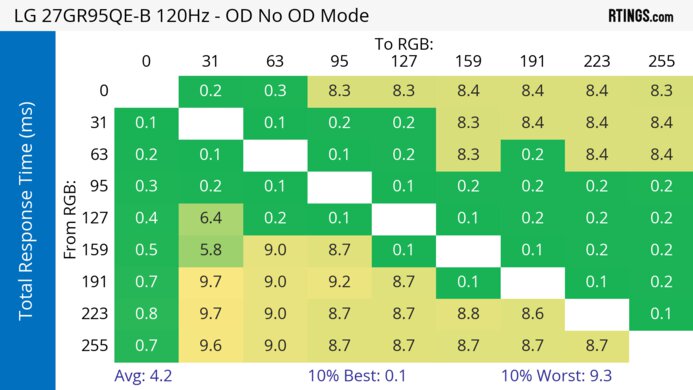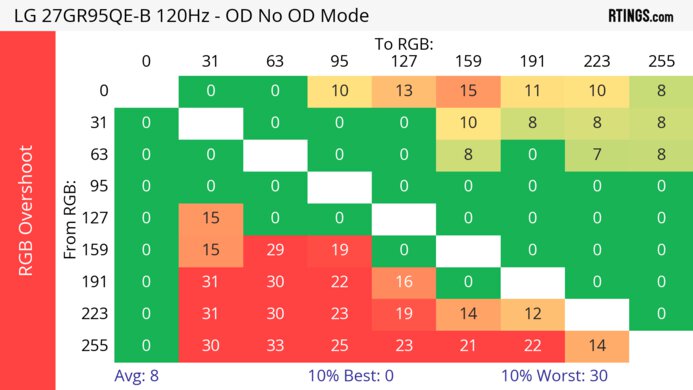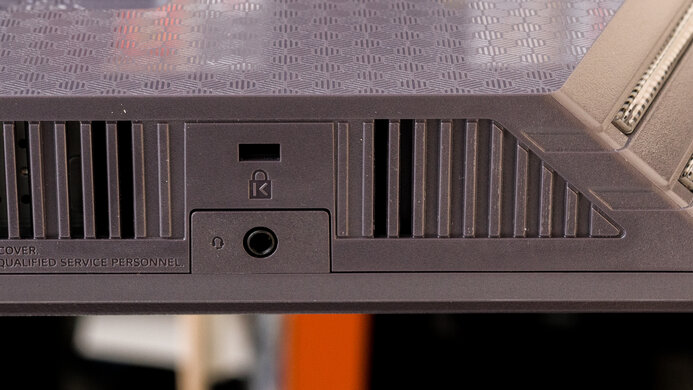The LG 27GR95QE-B is a 27-inch, 1440p gaming monitor with an OLED screen. It's one of the first OLED gaming monitors to feature a 240Hz refresh rate, and thanks to its DisplayPort 1.4 port and HDMI 2.1 bandwidth, you can reach its max refresh rate with any type of connection. It also has native FreeSync variable refresh rate (VRR) support and G-SYNC compatibility to reduce screen tearing. Unlike other larger OLEDs from LG, this monitor has a matte screen coating to reduce direct reflections, but it introduces some haziness to images. Like any OLED, it's prone to burn-in with constant exposure to static elements, but it has a few settings to try to reduce the risk of burn-in.

We buy and test more than 30 monitors each year, with units that we buy completely on our own, without any cherry-picked units or samples. We put a lot into each unbiased, straight-to-the-point review, and there's a whole process from purchasing to publishing, involving multiple teams and people. We do more than just use the monitor for a week; we use specialized and custom tools to measure various aspects with objective data-based results. We also consider multiple factors before making any recommendations, including the monitor's cost, its performance against the competition, and whether or not it's easy to find.
Our Verdict
The LG 27GR95QE-B is excellent for PC gaming. It offers a high 240Hz refresh rate with VRR support to reduce screen tearing. It also has low input lag for a responsive feel, and motion looks incredible thanks to its near-instantaneous response time, but it has inverse ghosting due to overshoot. Luckily, it's a great choice for dark room gaming as it displays perfect blacks without any blooming.
- Near-infinite contrast ratio.
- 240Hz refresh rate with VRR support.
- Motion looks sharp.
- No blooming around bright objects.
- Noticeable inverse ghosting.
- Distracting VRR flicker with changing frame rates.
The LG 27GR95QE is excellent for console gaming. It has HDMI 2.1 bandwidth to take advantage of the PS5 and Xbox Series X|S, but it's limited to a 1440p resolution. On the plus side, it has fantastic picture quality with deep blacks and no blooming, and it also has low input lag for a responsive feel. While motion looks sharp thanks to its fast response time, it has inverse ghosting with fast-moving objects.
- Near-infinite contrast ratio.
- HDMI 2.1 bandwidth for console gaming.
- Motion looks sharp.
- Noticeable inverse ghosting.
The LG 27GR95QE-B is decent for the office, but it has limitations. It has wide viewing angles and good ergonomics that make it easy to share the screen with a coworker or client, as they'll see a consistent image from the sides. While it has fantastic reflection handling, it doesn't get bright enough to fight intense glare. Unfortunately, it has some text clarity issues with color fringing, and its OLED panel is prone to burn-in with exposure to static elements over a long period.
- 27-inch screen.
- Good ergonomics.
- Fantastic reflection handling.
- Some text clarity issues due to RWBG layout.
- Low brightness.
- Risk of burn-in.
The LG 27GR95QE is excellent for content creators, with some limitations. The 27-inch screen is big enough to open two windows next to each other. It also has wide viewing angles and good ergonomics if you often need to share your screen with coworkers or clients. While it has an accurate sRGB picture mode and displays a wide range of colors, some colors look oversaturated. Also, its text clarity is just okay as there's color fringing around text, and it's also prone to burn-in, which could be problematic with static elements.
- 27-inch screen.
- Good ergonomics.
- Fantastic reflection handling.
- Near-infinite contrast ratio.
- Accurate sRGB mode.
- Some text clarity issues due to RWBG layout.
- Low brightness.
- Risk of burn-in.
The LG 27GR95QE-B has mediocre brightness. It isn't bright enough to fight intense glare, but it gets brighter in HDR as small highlights pop.
- Highlights pop.
- Low brightness.
The LG 27GR95QE has a fantastic response time. There isn't much blur trail behind fast-moving objects, but it has overshoot, leading to inverse ghosting.
- Motion looks sharp.
- Noticeable inverse ghosting.
The LG 27GR95QE-B is excellent for HDR. It displays a wide range of colors in HDR, and it also displays deep blacks without any blooming, thanks to its OLED panel. There isn't any blooming around bright objects either.
- Near-infinite contrast ratio.
- No blooming around bright objects.
- Not all colors are vivid in HDR.
The LG 27GR95QE has outstanding SDR picture quality. It displays deep and inky blacks in dark rooms, as well as a wide range of colors.
- Near-infinite contrast ratio.
- No blooming around bright objects.
The LG UltraGear 27GR95QE-B has excellent color accuracy. It has a very accurate sRGB mode, so you don't need to calibrate it for the best accuracy.
- Accurate sRGB mode.
Performance Usages
Changelog
- Updated Nov 18, 2025: We uploaded the latest brightness measurements and uniformity photos for the Accelerated Longevity Test.
- Updated Sep 26, 2025: We uploaded the latest brightness measurements and uniformity photos for the Accelerated Longevity Test.
- Updated Jul 08, 2025: We uploaded the latest brightness measurements and uniformity photos for the Accelerated Longevity Test.
- Updated Apr 17, 2025: We uploaded the latest brightness measurements and uniformity photos for the Accelerated Longevity Test.
Check Price
Differences Between Sizes And Variants
We tested the 27-inch LG 27GR95QE-B, which is the only size available for this model. LG released this monitor alongside the LG 45GR95QE-B, which is another 240Hz OLED monitor that performs similarly, but it has a 45-inch ultrawide screen.
| Model | Size | Panel Type | Resolution | Max Refresh Rate |
|---|---|---|---|---|
| 27GR95QE-B | 27" | OLED | 1440p | 240Hz |
Our unit was manufactured in January 2023, and you can see the label here.
Popular Monitor Comparisons
The LG 27GR95QE-B is an excellent gaming monitor that combines a fast 240Hz refresh rate with the incredible picture quality of an OLED. It's a great choice if you want the best of both worlds regarding picture quality and a smooth gaming feel, but it has some drawbacks. There's noticeable inverse ghosting with fast-moving objects, and colors aren't as vivid as on QD-OLEDs, so if that's important for you, then the Dell Alienware AW2725DF is a better choice. Even by going for the newer LG 27GS95QE-B, which has the same panel type, you get better performance with less inverse ghosting.
See our recommendations for the best 240Hz monitors, the best 1440p gaming monitors, and the best 27-inch gaming monitors.
The Corsair XENEON 27QHD240 and the LG 27GR95QE-B use the same panel and perform similarly. However, there are still a few differences as the LG gets brighter in HDR and has improved color volume, while the Corsair has less overshoot with fast-moving objects. The Corsair also has a few extra features, like USB-C ports and a KVM switch. They both support HDMI 2.1 bandwidth, but the LG supports 48 Gbps bandwidth compared to 24 Gbps on the Corsair, so your source doesn't need to use compression for demanding signals.
The LG 27GR95QE-B and the LG 27GS95QE-B are extremely similar 27-inch OLED gaming monitors. Both have the same 240Hz refresh rate and gaming features like VRR support. However, the 27GS95QE-B has better performance, with substantially higher brightness in SDR and HDR. Additionally, it has better motion handling with less inverse ghosting, making the 27GS95QE-B the better choice.
The LG 27GR95QE-B and the Dell Alienware AW2725DF are both 27-inch OLED gaming monitors. The Dell has a QD-OLED display, while the LG has a WOLED. The Dell has better gaming performance and image quality, a higher refresh rate, and more vivid HDR colors. However, the LG is still fantastic at gaming and media consumption. Additionally, the Dell's display appears slightly purple in a brighter environment, while the LG's doesn't.
The LG 27GR95QE-B and the ASUS ROG Swift OLED PG27AQDM use the same panel, but there are some differences in performance. The ASUS gets much brighter in HDR, making smaller highlights pop more, but you also need to make sure to update it to the latest firmware to get the best HDR performance. The ASUS also has an advantage with motion handling as it has less overshoot. One area where the LG has an advantage is that it has HDMI 2.1 bandwidth, letting it take full advantage of gaming consoles and high-end graphics cards. The LG also has a less aggressive ABL, so there aren't as many distracting changes in brightness in HDR.
Test Results

This monitor has a gamer-oriented aesthetic with a stylish design. It features some RGB lighting on the back and vents above the inputs.
The ergonomics are good. You can adjust it in any way, but the swivel range is limited, and you can only rotate it into portrait mode counterclockwise, meaning the inputs will always be on the right side of the monitor. Luckily, there's a clip on the stand for cable management to keep your setup clean.
The monitor's stand is solid, as there's minimal wobble, but it's big and takes up space. However, the V-shaped feet allow you to still place stuff like your keyboard and mouse between them.
The LG 27GR95QE-B has a remote to control the on-screen display, which is easier to use than traditional joysticks or buttons on monitors. There's a power button underneath the center of the monitor that also features RGB lighting next to it.
OLED panels like this one don't have a backlight, so they don't require a local dimming feature. However, with a near-infinite contrast ratio, there isn't any blooming around bright objects, and it's the equivalent of a perfect local dimming feature. We still film these videos on the monitor so you can see how the screen performs and compare it with a monitor that has local dimming.
The LG 27GR95QE has disappointing SDR peak brightness. It doesn't get bright enough to fight glare, and large areas like full-screen webpages are dim. These results are from after calibration in the 'Gamer 2' Game Mode, which is the name of the picture mode setting, with the Brightness at its max and Smart Energy Saving disabled. If you want something that gets brighter in SDR, consider the ASUS ROG Strix OLED XG27AQDMG.
The SDR brightness is a bit brighter in picture modes that aren't optimized for gaming, like 'Vivid', 'Reader', 'HDR Effect', 'sRGB', 'Color Weakness', 'Calibration 1', and 'Calibration 2'. Using any of these modes also disables the DAS feature, which increases the Input Lag too. You can see some results in the 'Vivid' mode below:
- Peak 2% Window: 365 cd/m²
- Peak 10% Window: 373 cd/m²
- Peak 25% Window: 372 cd/m²
- Peak 50% Window: 218 cd/m²
- Peak 100% Window: 135 cd/m²
The HDR brightness is okay. It gets brightest with small highlights, making them stand out against the rest of the screen, but it still isn't bright enough overall for a vivid HDR experience. It also has an aggressive Automatic Brightness Limiter (ABL) that makes large areas considerably dimmer. The changes in brightness can be noticeable in some scenes when playing games, but it isn't too distracting. The EOTF also follows the target PQ curve perfectly until there's a sharp roll-off at the peak brightness, causing a loss of fine details with bright scenes. If you're looking for a monitor with better HDR brightness, check out the LG 27GS95QE-B.
These results are in the 'Gamer 1' Game Mode with the Brightness at its max and Smart Energy Saving disabled. The 'Vivid' Game Mode gets much brighter, but the overall picture quality is worse because colors are inaccurate and the white balance is off. You can see the results in 'Vivid' below:
- Peak 2% Window: 854 cd/m²
- Peak 10% Window: 701cd/m²
- Peak 25% Window: 419 cd/m²
- Peak 50% Window: 236 cd/m²
- Peak 100% Window: 138 cd/m²
- Sustained 2% Window: 839 cd/m²
- Sustained 10% Window: 684 cd/m²
- Sustained 25% Window: 416 cd/m²
- Sustained 50% Window: 236 cd/m²
- Sustained 100% Window: 138 cd/m²
- ABL: 0.034
- EOTF
The horizontal viewing angle is remarkable. The image remains the same no matter where you view the screen from, which is great for co-op gaming.
The vertical viewing angle is once again incredible. While colors start to shift earlier from below than from on top, you won't notice any difference and the image remains consistent when looking down on it or if you have it mounted above eye level.
The gray uniformity is great. The edges are a bit darker than the rest of the screen, but there's minimal dirty screen effect in the center. Like any OLED screen, there are thin vertical lines in near-dark scenes, but they're hard to notice unless you're looking for them.
The accuracy before calibration is incredible. The sRGB mode locks the colors well to the sRGB color space, and there are minimal inaccuracies with colors and the white balance. The color temperature is also close to the 6500K target. However, gamma doesn't follow the sRGB curve well, as most scenes are brighter than they should be. Unfortunately, using this accurate sRGB mode locks most picture settings, including Black Stabilizer and Gamma. If you want to adjust those settings, the 'Gamer 2' Game Mode is less accurate with oversaturated colors and a brighter gamma.
The accuracy after calibration is great, but it's worse overall than before calibration because colors are more oversaturated. However, everything else is nearly perfect, including the gamma and color temperature, and you won't easily notice any inaccuracies in the image. By default, the Black Stabilizer setting is '60' when you use the 'Gamer 2' Game Mode, but set it to '50' for better black levels.
The SDR color gamut is fantastic. It has fantastic coverage of the sRGB and Adobe RGB color spaces, but it, unfortunately, does this by oversaturating colors, so primary colors are still off.
The LG 27GR95QE has a remarkable HDR color gamut. It has incredible coverage of the commonly-used DCI-P3 color space, but it's more limited with the wider Rec. 2020 color space.
The HDR color volume is good. It displays dark colors well thanks to its near-infinite contrast ratio, but it doesn't display bright colors as bright as QD-OLEDs like the Samsung Odyssey OLED G8/G85SB S34BG85.
This monitor has okay text clarity, but it's worse than other 27-inch, 1440p monitors. This is because of its RWBG subpixel layout, as computer programs don't render text properly with this layout. This results in some color fringing around text, and while it isn't the worst case of color fringing, it can be distracting if you're sitting close and notice text clarity issues easily. The matte screen finish also makes text look a bit hazy. If you prefer a 4k QD-OLED monitor with better text clarity and a glossy screen, look into the Dell Alienware AW3225QF.
Enabling Windows ClearType (top photo) can help improve the text clarity, but it can introduce some of the color fringing. This means you either have to choose between sharper text with color fringing or worse text clarity without the fringing. These photos are with Windows 10, and you can see what it looks like in Windows 11 with ClearType on here, and with ClearType off here.
Due to the RWBG subpixel layout, all four pixels are never on at the same time. You can see additional photos of the pixels below:
The LG 27GR95QE has fantastic reflection handling. Its matte coating is very different from the glossy coatings on other OLEDs like the LG 42 C2 OLED or the Dell Alienware AW3423DWF. It does a good job of reducing strong reflections, but placing it opposite a bright light source can still be distracting. The main downside to this type of screen coating is that the image doesn't look as clear as glossy monitors, and some text can look hazy.
You can reach the monitor's max refresh rate over any connection, but your graphics card needs to support Display Stream Compression (DSC) for 10-bit signals over DisplayPort. If you want a monitor with an even higher refresh rate, take a look at the Dell Alienware AW2725DF.
When setting a fixed refresh rate of 120Hz in the NVIDIA Control Panel, the monitor displays a non-native resolution of 3840x2160, which is downscaled to 1440p. With a DisplayPort connection, you can fix this by setting Perform Scaling On to 'Display' instead of 'GPU' in the NVIDIA Control Panel. After making this change, the monitor properly displays 1440p @ 120Hz. However, you can't use the same solution over HDMI as it's still downscaled 4k, even after changing the scaling mode to 'Full Screen' instead of 'No Scaling'. However, we didn't experience any of these issues with a console, and we don't expect it to be a big problem for most people as it only occurs when sending a fixed 120Hz refresh rate and not with VRR enabled.
| NVIDIA | VRR Min | VRR Max |
| DisplayPort | <20Hz | 240Hz |
| HDMI | <20Hz | 240Hz |
| AMD | VRR Min | VRR Max |
| DisplayPort | <20Hz | 240Hz |
| HDMI | <20Hz | 240Hz |
On top of supporting FreeSync VRR and G-SYNC compatibility, it also supports HDMI Forum VRR.
| Refresh Rate | CAD Heatmap | RT Chart | Pursuit Photo |
| 238 | Heatmap | Chart | Photo |
| 165 | Heatmap | Chart | Photo |
| 144 | Heatmap | Chart | Photo |
| 120 | Heatmap | Chart | Photo |
| 100 | Heatmap | Chart | Photo |
| 80 | Heatmap | Chart | Photo |
| 60 | Heatmap | Chart | Photo |
The LG 27GR95QE has fantastic motion handling across its VRR range. While there's minimal blur trail with fast-moving objects, it has more noticeable inverse ghosting at lower refresh rates, which is distracting.
The refresh rate compliance is fantastic. Although it isn't as good as other OLEDs because it has some overshoot, it's still good enough to make color transitions before the monitor draws the next frame.
The LG 27GR95QE-B doesn't have a black frame insertion feature to reduce persistence blur.
This monitor has noticeable VRR flicker with changing frame rates. It's obvious and distracting, and you can mostly notice it in dark scenes or in dark areas of brighter scenes. This issue doesn't occur with a consistent frame rate or if you disable VRR altogether. If you're looking for an OLED with a feature to significantly reduce VRR flicker, check out the Samsung Odyssey OLED G6/G60SD S27DG60.
The LG UltraGear 27GR95QE-B has low input lag resulting in a responsive gaming experience. It remains low no matter the frame rate you're gaming at as long as you're using a picture mode that enables DAS. Testing was done with a DisplayPort connection with VRR disabled, and the input lag doesn't change even over HDMI.
The input lag increases in picture modes that aren't optimized for gaming, like 'Vivid', 'Reader', 'HDR Effect', 'sRGB', 'Color Weakness', 'Calibration 1', and 'Calibration 2'. Using any of these modes disables the DAS feature, which is why the input lag increases. You can see the input lag in the 'sRGB' and 'Calibration 1' modes, which are the same:
- Native Resolution @ Max Refresh Rate: 7.1 ms
- Native Resolution @ 120Hz: 13.5 ms
- Native Resolution @ 60Hz: 26.1 ms
The LG 27GR95QE works well with the PS5 thanks to its HDMI 2.1 bandwidth. It even downscales 4k signals, which results in a sharper image than a native 1440p signal. The console works without issue when playing lower frame-rate games, like at 60 or even 30 fps.
This monitor doesn't have any compatibility issues with the Xbox Series X|S, thanks to its HDMI 2.1 bandwidth. It even downscales 4k games, which allows you to play games in HDR as the console only supports HDR in 4k.
The 3.5mm audio output serves as a combo jack with both audio out and mic in, but you need to have the USB-B cable connected to your computer to make full use of it. It also comes with DTS Headphone:X to simulate surround sound audio. Unlike many monitors, it has an Optical Audio output to connect to soundbars or speakers with this connection, but it doesn't support DTS/DTS:X audio passthrough.
You need to connect the USB-B to USB-A cable to your computer for the USB ports to work. It doesn't have a USB-C port, but if you want a similar monitor that has one, you can also check out the Corsair XENEON 27QHD240.
The LG 27GR95QE-B works well with macOS. VRR works well, and there isn't any obvious flickering on the desktop or in games. However, there's a thin gray line on top of the screen with some games, and disabling VRR removes it. Unfortunately, HDR looks washed out, which is a limitation of macOS with some monitors. If you're using a MacBook, windows return to their original position after waking the laptop up from sleep, but not after you reopen the lid.
The text clarity seems to be a bit better in macOS than Windows, but the difference is minor. You can see what the text clarity looks like with font size 11 here and with font size 13 here.
The LG 27GR95QE has a few extra additional features, including:
- Crosshair: Adds a virtual crosshair that your system won't detect.
- DTS Headphones:X: This only works with the 3.5mm audio output and not the Optical Audio output. There are three modes for this: Sports, Entertainment, and Game.
- Dynamic Action Sync: Mode that's automatically enabled and aims to lower the input lag.
- FPS Counter: Displays the frame rate of your source.
- LG Calibration Studio: This is a downloadable software that aims to automatically calibrate the monitor. We didn't use it for calibration.
- Optical Audio Out: Lets you connect a soundbar or speakers that support this connection.
Like most OLED displays, there are also a few settings to help reduce the risk of burn-in:
- Pixel Cleaning: Corrects individual pixels. Occurs after 500 hours of use and only starts once you turn the monitor off or enter the power-saving mode. It only lasts about a minute.
- Image Cleaning: Runs a complete image refresh cycle after four hours of use and only starts when you turn the monitor off or enter the power saving mode. It takes about 10 minutes to finish.
- Screen Move: Moves the image by a few pixels to one side to help reduce the risk of burn-in.
- Screen Saver: Automatically turns the screen off when there's inactivity.
Burn-in can occur with constant exposure to the same static elements over time, so the best ways to reduce the risk of burn-in is by watching varied content, hiding the taskbar, using a black background, and taking advantage of these features in the OLED Care settings. Unfortunately, LG's warranty doesn't cover burn-in. You can learn about our current longevity and burn-in test here.







































